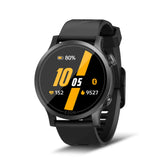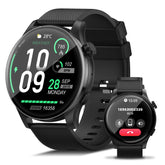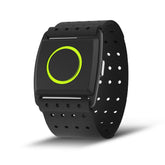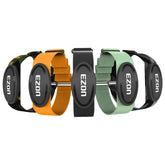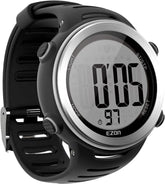Triathlon Training Essentials: Tips and Tricks
Training for a triathlon is a thrilling challenge that demands mastery of three disciplines: swimming, cycling, and running. Whether you’re a first-time triathlete or aiming to improve your race time, a strategic approach to each segment—paired with the right gear like a sports watch—can elevate your performance. In this guide, we’ll share essential tips for each discipline, transition training, and recovery, helping you tackle the swim-bike-run challenge with confidence.
1. Swimming: Build Efficiency and Endurance
The swim segment sets the tone for your race. Focus on technique to conserve energy for the bike and run.
Training Tips:
- Drill Work: Incorporate drills like catch-up drills or single-arm freestyle to improve stroke efficiency. Aim for 2–3 swim sessions weekly, mixing drills with distance sets (e.g., 4x400m at race pace).
- Open-Water Practice: Train in open water at least twice a month to adapt to choppy conditions, sighting, and drafting. Use a sports watch with swim mode to track lap count and stroke rate.
- Breathing Discipline: Practice bilateral breathing (every 3 strokes) to maintain balance and reduce neck strain.
Gear Essentials:
- Wetsuit (for cold water): Choose a model with buoyant materials to lift your legs and reduce drag.
- Swim Cap and Goggles: Opt for mirrored goggles for open-water sun protection and a silicone cap to reduce water resistance.
2. Cycling: Develop Power and Pacing
The bike segment is where you can make up time, but overexertion can sabotage your run. Focus on sustainable power and smooth transitions.
Training Tips:
- Interval Training: Include high-intensity intervals (e.g., 10x1-minute sprints at 90% FTP) to boost anaerobic capacity, paired with steady-state rides (2–3 hours at 70% FTP) for endurance.
- Bike-to-Run Transitions: Practice “brick” workouts (30-minute bike + 15-minute run) to acclimate your legs to running with fatigued muscles. Use a sports watch to track cadence and heart rate during rides.
- Hill Repeats: Build leg strength with 5–10 uphill efforts at high resistance, improving your ability to tackle race-day climbs.
Gear Essentials:
- Aerodynamic Bike: Reduce wind resistance with aero bars or a triathlon-specific bike.
- Clip-In Pedals: Improve pedaling efficiency and power transfer—practice clipping in/out to avoid race-day fumbles.
3. Running: Build Resilience and Race Pace
The final segment demands mental toughness. Train your body to run efficiently after swimming and cycling.
Training Tips:
- Pace Specificity: Run at your target triathlon pace (slower than standalone 10K pace) during long runs and tempo sessions. A sports watch with GPS ensures you hit precise splits.
- Progressive Overload: Gradually increase running volume by 10% weekly to avoid injury, incorporating hill runs and fartleks for strength and speed.
- Post-Bike Running Drills: After cycling, practice short sprints to reactivate leg muscles and improve stride turnover.
Gear Essentials:
- Lightweight Running Shoes: Choose shoes with minimal drop (4–8mm) for a natural stride, breaking them in during brick workouts.
- Socks and Anti-Chafe Cream: Prevent blisters and skin irritation during long runs—test products in training to avoid race-day surprises.
4. Transition Training: The Fourth Discipline
Smooth transitions can save minutes. Practice these steps:
- Swim to Bike: Remove the wetsuit quickly (practice peeling it off while standing), put on cycling shoes, and grab your bike.
- Bike to Run: Rack the bike, switch to running shoes, and take 30 seconds to steady your heart rate before starting the run.
- Pro Tip: Lay out gear in order of use during transitions and practice at least once a week to build muscle memory.
5. Recovery and Nutrition: Fuel for Performance
Recovery Strategies:
- Active Recovery: Use yoga or foam rolling to reduce muscle tightness, especially in the hips and shoulders from swimming.
- Sleep and Heart Rate Monitoring: Track resting heart rate with a sports watch—a consistent or decreasing RHR signals improving fitness.
Nutrition Tips:
- During Training: Consume 30–60g of carbs per hour (gels, sports drinks) during workouts over 90 minutes.
- Race Day Fueling: Practice your nutrition plan in training (e.g., a gel every 45 minutes on the bike) to avoid stomach issues.
6. Gear Up with a Triathlon-Ready Sports Watch
- Multi-Sport Modes: Auto-detects swim, bike, and run segments, tracking metrics like stroke rate, cadence, and pace.
- GPS and Heart Rate Accuracy: EZON’s sports watches offer precise route mapping and heart rate monitoring, even in open water or during high-intensity efforts.
- Battery Life: Up to 20 hours in GPS mode ensures it lasts through full-distance triathlons without charging.
Race Day Mindset: Stay Calm and Consistent**
- Pace Yourself: Start the swim conservatively, maintain a steady bike pace, and trust your legs on the run.
- Embrace Transitions: View them as opportunities to catch your breath and reset, not just moments to rush.
- Celebrate Progress: Whether it’s a PR or finishing your first triathlon, acknowledge the hard work—every training day counts.
Train Smarter, Race Stronger**
Triathlon training is a journey of discipline and adaptability. By focusing on technique in swimming, pacing in cycling, and resilience in running, and using a reliable sports watch to track progress, you’ll be prepared to conquer each segment and cross the finish line with pride.
Remember, the key to success is consistency—pair these tips with a structured plan, and let your training reflect the dedication triathlons demand. Ready to take the plunge? Gear up, stay focused, and let every swim, bike, and run bring you closer to race-day excellence.
